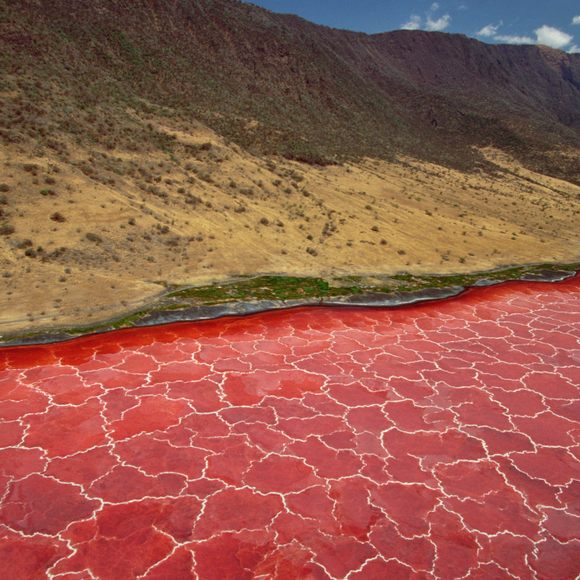- Home
- Safaris
- Volunteering
- Responsible Trips
- Faq’s
- Cost of Tanzania Safari
- Is it Safe to Visit Tanzania?
- When to Visit Tanzania
- How to book a Tanzania Safari?
- Vaccinations for Tanzania safari
- Booking Flights
- Sustainable Travel in Tanzania
- Why Travel to Tanzania?
- Meals during a Tanzania safaris
- Tanzania Visa Information
- Responsible Travel in Tanzania
- Toilets on Safari
- Recommended duration for a safari in Tanzania
- What to wear during a Tanzania Safari
- Information About Tipping during Tanzania safari
- Which is the cheapest safari?
- About us
- Contact
- Share a Home with us
Explore the lake Natron
ABOUT LAKE NATRON
Lake Natron, located in East Africa, is a unique and otherworldly body of water renowned for its extraordinary chemical composition and its impact on the surrounding ecosystem. Situated in the northern part of Tanzania, near the Kenyan border, this salt lake is part of the East African Rift system and is nestled in the eastern branch of the East African Rift Valley.
One of the most striking features of Lake Natron is its distinct red color, which is primarily due to the high concentration of minerals and salts in the water, including sodium carbonate, sodium bicarbonate, and other alkaline compounds. These chemicals are derived from the nearby volcanic deposits, particularly from the Ol Doinyo Lengai volcano, which is often referred to as the “Mountain of God” by the indigenous Maasai people

FEATURES
The extreme alkalinity and salinity of Lake Natron make it a harsh and inhospitable environment for many forms of life, but it has become a unique habitat for certain species that have adapted to its challenging conditions. The lake’s alkaline waters can reach pH levels as high as 10.5, which is similar to the pH of ammonia, making it uninhabitable for most aquatic creatures. Nevertheless, Lake Natron supports a remarkable population of extremophiles, including the alkaline tilapia fish (Alcolapia alcalica), which has evolved specific mechanisms to survive in this harsh environment.
Lake Natron also serves as a crucial breeding ground for flamingos, particularly Lesser Flamingos (Phoeniconaias minor). These pink-hued birds are drawn to the lake because of the abundant food supply, primarily cyanobacteria and other microorganisms that thrive in the high-pH waters. The flamingos’ vibrant pink coloration is a result of the pigments they obtain from their diet at Lake Natron.
The surrounding landscape of Lake Natron is equally stunning, with dramatic and arid vistas. The desolate plains of the surrounding area, along with the backdrop of the Ol Doinyo Lengai volcano, create a surreal and almost Martian-like landscape.
Despite its harsh conditions, Lake Natron has attracted attention from scientists, photographers, and nature enthusiasts who are intrigued by its unique beauty and ecological significance. It also faces certain conservation challenges, including potential threats from nearby infrastructure developments and water diversion projects that could alter its fragile ecosystem.
Visitors to Lake Natron can witness the extraordinary interplay of geology, chemistry, and biology in this remote and intriguing location. It is a reminder of the Earth’s capacity to create and sustain life in the most unexpected and extreme environments, offering a glimpse into the resilience and adaptability of the natural world.

Best Time to Visit:
Lake Natron can be visited year-round, but the best time to experience its unique features and wildlife depends on your interests and priorities:
Dry Season (June to October): This period is often considered the best time to visit Lake Natron. The weather is dry and relatively cooler, making it more comfortable for outdoor activities. The flamingos are usually more concentrated during this season.
Wet Season (November to May): The wet season can be a fascinating time to visit if you are interested in seeing the changing landscapes, migratory birds, and lush vegetation. However, the roads can become challenging to navigate due to rain, and the flamingo population may be more dispersed.
Getting There:
By Air: The closest airstrip to Lake Natron is the one at Kogatende. You can fly into Kilimanjaro International Airport (JRO) or Arusha Airport (ARK) in Tanzania and then take a domestic flight to Kogatende Airstrip. From there, you can arrange ground transportation to Lake Natron.
By Road: Access to Lake Natron by road can be somewhat challenging, as the area is remote and the roads may be rough. You’ll need a sturdy 4×4 vehicle and, preferably, a local guide who is familiar with the terrain. Most visitors opt for the convenience of air travel to reach Lake Natron.
Entry Points:
Lake Natron doesn’t have official entry points like a national park. It’s important to coordinate your visit with local tour operators or guides who are experienced in navigating the area. They can assist you with the logistics and ensure a safe and enjoyable visit.
Accommodations:
Accommodations near Lake Natron are limited but can be found in the nearby town of Engare Sero. These lodges and camps provide a comfortable base for exploring the lake and its surroundings.
